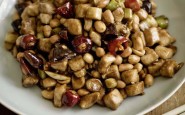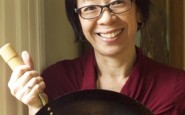Chinese new year cake
In China, New Year’s cakes were made in bamboo steamers two feet across and a foot high. The strenuous task of working large quantities of batter was one of the few cooking assignments given to the men in the family. Large, pliable banana leaves lined the steamers to keep batter from overflowing the sides as the cake expanded during cooking. A full day of steaming was required to cook the cakes thoroughly. This version is much easier.
Don’t expect a light cake full of airpockets. This chewy cake, lightly sweetened with yams and Chinese brown sugar, is more like a soft caramel. We never did this, but in some villages, ½cup Chinese sausage or pork fat cut in 1/4-inch dice is kneaded into the batter.
The cake can be made 1 to 3 days in advance and should be refrigerated after the first or second day. Leftover cake may be cut into 1/2-inch-thick slices, dipped in beaten eggs, fried until browned over medium heat in an oiled non-stick skillet 1 to 2 minutes on each side, and served with maple syrup. The cake will be slightly crisp on the outside and chewy inside.
1 lb Chinese brown sugar bars
1 3/4 cups water
1 1/2 tsp vegetable or peanutoil
4 3/4 cups glutinous rice flour
1 and a third cups mashed, cooked or canned yams
1 jujube, for garnish (optional)
1/4 tsp sesame seeds, for garnish(optional)
Method
In a small saucepan, bring the sugar and water to a boil. Lower the heat and simmer 6 or 7 minutes, until the sugar has dissolved. Set aside to cool until it is barely warm. When cooled, mix in the oil and reserve 1/4 cup of the syrup.
In a large bowl, combine the flour and yams. Add the remaining syrup and mix in with your hands, lifting the batter between your fingers and squeezing it back into the bowl. The batter becomes very sticky and thick; working it requires a lot of effort. Work the batter at least 10 minutes; the longer it is worked, the better and chewier the cake will be.
Generously oil a 9-inch round cake pan or a 1 1/2 to 2-quart heat-proof bowl. (A bowl with straight sides such as asouff1é dish works best.) Pour the batter into the pan, wet your hands, and pat the top smooth. Rap the pan sharply against the counter top to force air bubbles to rise to the top. Break the bubbles with your fingertips and smooth over. Spread the reserved syrup over the top.
Set a rack in a pot and add water to a depth of 2 inches. (If you are using a steamer add water to the lower tier until almost full.) Bring to a boil. Lower the pan onto the rack (or put on the upper tier of a steamer). Steam the cake over high heat for 4 hours, replenishing the pot with boiling water every 20 to 30 minutes as the water in the pot evaporates. You may want to add the water through a large metal funnel because the water must not splash onto the cake.
If you like, about 5 minutes before the cake is done, you can put a jujube in the middle of the top of the cake (for luck) and/or sprinkle with sesame seeds.
Remove the cake from the pot or steamer, let the cake cool to room temperature, cover it with foil, and let it rest overnight. (Refrigerate it if you are making it more than 1 day ahead. Reheat it by steaming 10 minutes, then let it cool again to room temperature unless you like a very soft, sticky cake.) Turn the cake out onto a serving plate and cut it into ¼-inch-thick slices.
NOTE: The recipe may be doubled. You may have to add a little extra rice flour to the batter because you do not double the amount of syrup reserved for the top of the cake. Steam the cake in an oiled 4 1/2-quart heatproof bowl for 6 to 7 hours.
This cake freezes well. Let it thaw, then steam 20 to 30 minutes, depending on the size of the cake section. You mayalso cut thawed cake into 1-inch slices and microwave it, covered, on medium heat for 1 minute.
Taken from Ellen Blonder and Annabel Low’s book “Every Grain of Rice” with permission. © Ellen Blonder and Annabel Low, 1998. Published by Clarkson N. Potter, Inc. ISBN 0-609-60102-4.


